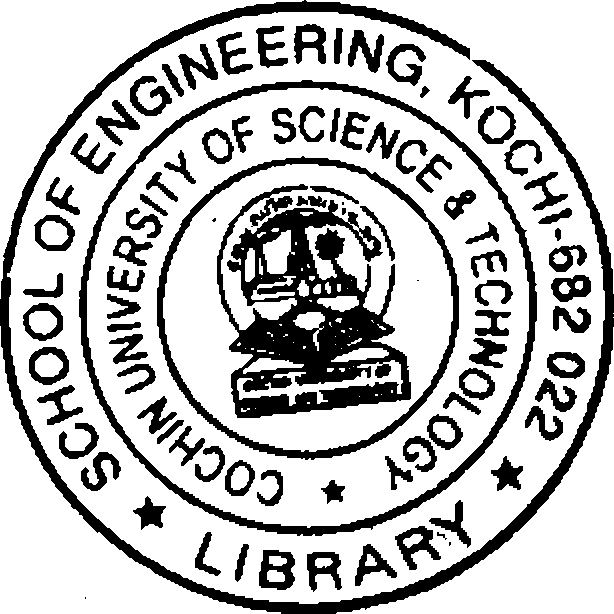Cochin University of Science and Techology (CUST) 2005-5th Sem B.Tech Civil Engineering ,, Geotechnical Engineering I - Question Paper
BTS (C) - V - 05 - 060 (I)
B. Tech Degree V Semester Examination November 2005
CE 501 A/B GEOTECHNICAL ENGINEERING I

(2002 Admissions onwards)
BTS (C) - V - 05 - 060 (I)
Maximum Marks: 100
Time : 3 Hours
Explain the following terms:
(a)
(b)
(a)
(b)
(i) Three phase system (ii) Degree of saturation (iii) Absolute specific gravity (iv) Relative consistency (v) Transported soil (vi) HoneyCombed structures. (12)
The weight of saturated clay in a shrinkage limit test was found to be 0.1875N and its dry weight was 0.1215 N. The volume of the sample shrinks from 10.5ml at saturated state to 5.95ml at dry state. Determine the shrinkage limit. (8)
OR
Discuss the uses of consistency limits and how it is made use in the classification of soil. (10) Establish the relation between degree of saturation void ratio, bulk unit weight and specific gravity of soil solids. (10)
III. (a) A 6m thick sand layer having dry unit weight of 17kN/m lies above a clay layer.
The water table is 1m below ground surface and the unit weight of saturated sand
above water table is 20KN/m . Plot the effective stress variation in sand layer
assuming sand is saturated by the capillary action. (8)
(b) Derive expression for average permeability of a stratified deposit when the flow is perpendicular to the bedding plane. (5)
(c) Explain flow net diagram and its uses. How will you determine the topmost flow line
in an earth dam? (7)
OR
IV. (a) A bed of sand is composed of three horizontal layers of equal thickness. The value of the
coefficient of permeability of each layer is given below:
Upper layer = lxl0"3 cm/sec, middle layer = lxl0'2 cm/sec, lower layer = lxl0"3 cm/sec. Calculate average k of the bed in the horizontal direction to that in the vertical direction. Instead if the values of the coefficients are lxl O'2 cm/s for upper and lower layers and lxlO'3 cm/sec for the middle layer. What will be this ratio? (8)
(b) Differentiate between total, effective and pore water pressure in soil, (4)
(c) A 30cm diameter well penetrates 25m below the static water table. The water level in a test well at 90cm is lowered by 0.53m and that in a well at 30 m away is lowered by
1.11m after 24 hrs. of pumping at 5400 1/minutes. Determine transmissibility of the aquifer and draw down in the main well. (8)
V. (a) Discuss the validity of assumptions made in the theory of consolidation. (6)
(b) What do you mean by pre consolidated clay and how will you determine pre consolidated pressure?
(c) The average value of coefficient of consolidation is 50 x 10"4 cm2/sec for a 6 m thick clay stratum. If it is draining at both ends how many days it would take to reach 50%
of its ultimate settlement. (8)
OR
VI. (a) Explain the process of consolidation of clay and differentiate between primary
and secondary consolidation. (6)
(b) The average effective pressure in consolidated clay layer 3m thick is doubled due to the construction of a structure. The initial void ration of soil is 1.0 and L.L of the
(c) Differentiate between compression index and coefficient of compressibility. (4)
(a) Classify and briefly explain the triaxial shear tests based on drainage conditions. (8)
VII.
(b) A sample of sand having angle of internal friction 30 failed under a major principal stress of 300kPa with a corresponding minor principal stress of lOOkPa. If for the same soil, the minor principal stress had been 200kPa, what would have been the major principal stress at failure? (8)
(c) Explain Mohr - Coloumb theory. (4)
OR
(a) Define critical voids ratio for sand and explain its significance. (4)
VIII.
(b) A cylindrical soil during an UCC test failed at an axial load of 160lCN/m2 and the
(c) Discuss the vane shear test and derive the relationship used for the analysis of the
test result (8)
(a) What is the compaction curve and give salient features of it? (6)
IX.
(iii) Write notes on :
(i) Compaction control (ii) zero air void line (iii) placement water content (6)
(c) Determine the factor of safety of vertical foundation trench 5m deep if C= 50KN/m2 and angle of friction 25 Take unit weight of soil as 17lCN/m3. Assume Taylors stability number Sn=0.166. (8)
OR
(a) Bring out the difference between Swedish circle method and friction circle method
(b) A cohesive soil yields a maximum dry density of 18KN/m3 at an OMC of 16% during a standard proctor test. If the value of G is 2.6, obtain the degree of saturation.
(c) Differentiate between compaction and consolidation. (6)
|
Attachment: |
| Earning: Approval pending. |
